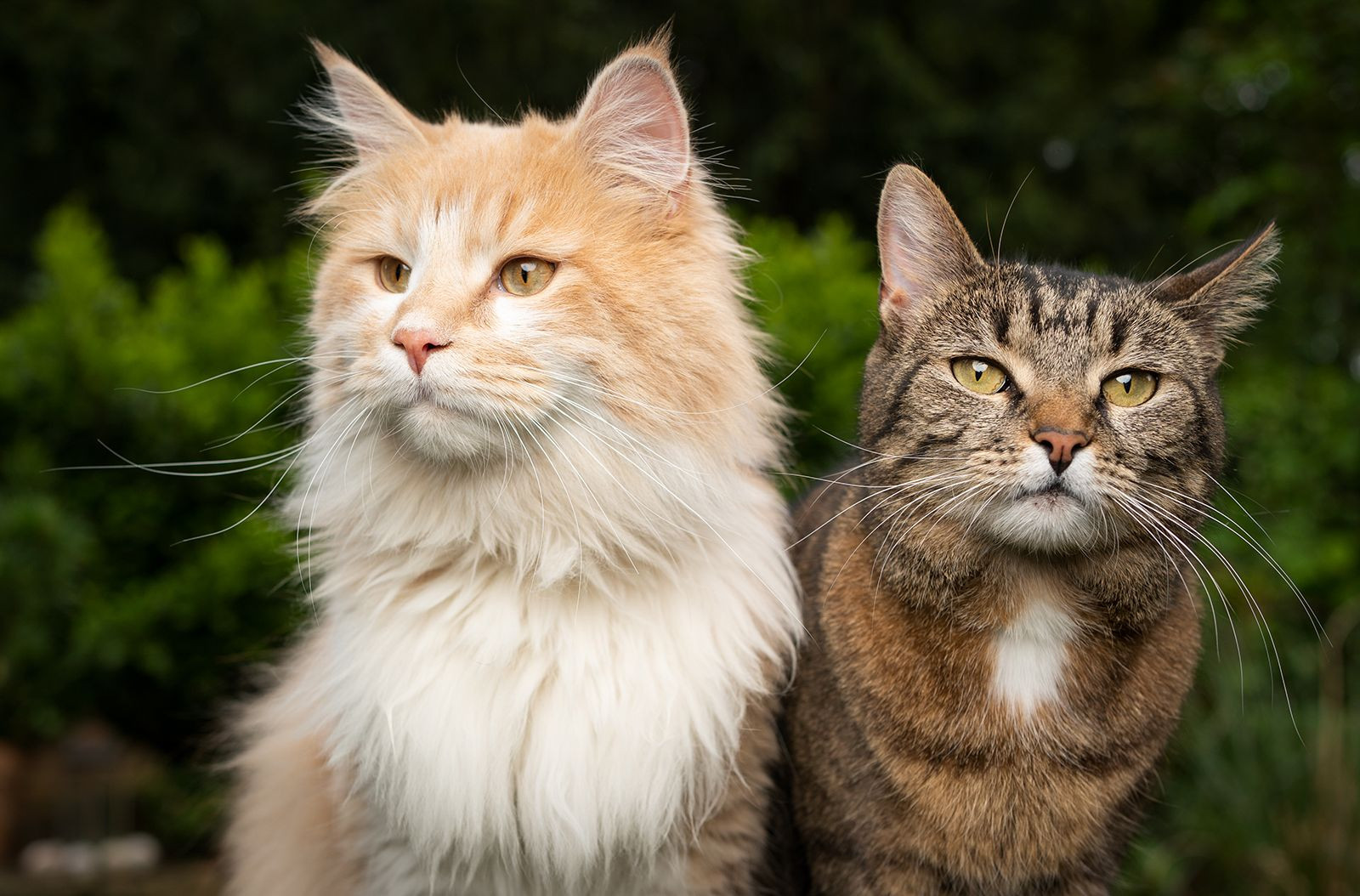Cats, often shrouded in mystery and admired for their independence, are among the most beloved pets globally. But What Is A Cat truly? Delving beyond their charming purrs and playful antics reveals a complex and fascinating creature, shaped by millennia of evolution and a unique relationship with humans. This article will explore the essence of a cat, from its biological classification to its intricate behaviors and cultural significance.
 Two domestic cats of different breeds sitting side-by-side outdoors, showcasing feline diversity.
Two domestic cats of different breeds sitting side-by-side outdoors, showcasing feline diversity.
Defining the Domestic Cat: Felis catus
Scientifically known as Felis catus, the cat, also referred to as the domestic cat or house cat, is a carnivorous mammal belonging to the family Felidae. This family also includes formidable predators like lions, tigers, and leopards, making the domestic cat the smallest member of this powerful lineage. Despite its size, the domestic cat retains the quintessential feline traits: agility, acute senses, and remarkable hunting prowess.
Biological Classification and Evolutionary Roots
To understand what is a cat, we must trace its evolutionary journey. The feline lineage began approximately 30 million years ago with Proailurus, a small, civet-like mammal. Cats resembling modern felids emerged during the early Pliocene Epoch (5.3 to 3.6 million years ago), maintaining their fundamental design with minimal alterations. This enduring blueprint, characterized by sharp fangs and claws, a flexible spine, muscular strength, and agility, has enabled cats to thrive and adapt across diverse environments.
Domestication: A Unique Partnership
Unlike dogs, domesticated over 30,000 years with significant physical and behavioral changes, domestic cats remain remarkably similar to their wild ancestors. The closest wild relative, the African wildcat (Felis silvestris lybica), shares nearly identical genetics with domestic cats and readily interbreeds, blurring the lines between wild and domestic populations. This close genetic proximity underscores a key aspect of what is a cat: a creature that has entered into a partnership with humans more so than undergoing complete domestication.
 European wildcat with a rabbit prey, illustrating the wild ancestor of domestic cats.
European wildcat with a rabbit prey, illustrating the wild ancestor of domestic cats.
The association between cats and humans likely began with the advent of agriculture in the Middle East around 15,000–10,000 years ago. Attracted to rodents that plagued grain stores, wildcats forged a mutually beneficial relationship with humans. This evolved from pest control to companionship, evidenced by a 9,500-year-old grave in Cyprus containing both human and cat remains, suggesting a bond beyond utility.
Cultural Significance and Mythology
What is a cat transcends biology; it’s deeply intertwined with human culture. Ancient Egypt revered cats, elevating them from pest controllers to divine symbols. Bastet, the cat-headed goddess, embodied protection, fertility, and motherhood. Cats adorned royal jewelry, featured prominently in art, and were even mummified, reflecting their profound social and spiritual importance.
Beyond Egypt, cats appear in diverse cultures and mythologies. Norse mythology features Freyja, a goddess whose chariot is drawn by cats. In Japan, the maneki-neko or “beckoning cat” symbolizes good fortune. Conversely, in some Western cultures, black cats have been associated with superstition and witchcraft, highlighting the complex and often contradictory perceptions of cats throughout history.
Physical Characteristics: Anatomy and Senses
What is a cat physically? Domestic cats share fundamental anatomical traits with their wild feline counterparts. Their bodies are designed for agility and hunting:
- Body Structure: Cats possess retractable claws, powerful musculature, acute senses, and long tails aiding in balance. They are digitigrade, walking on their toes for silent movement.
- Teeth: Specialized teeth for stabbing, anchoring, and cutting prey, lacking flat teeth for chewing.
- Claws: Retractible claws are formidable weapons, deployed for hunting and defense.
- Ears: Highly mobile ears with exceptional hearing range, capable of swiveling 180 degrees for precise sound localization.
- Tail: A mobile tail used for balance and communication.
- Skin and Hair: Bristle-inducing muscles and three hair types (guard, awn, and down) for insulation and sensory perception.
 Diagram illustrating the anatomy of a cat, highlighting key physical features and adaptations.
Diagram illustrating the anatomy of a cat, highlighting key physical features and adaptations.
Cats are renowned for their exceptional senses, crucial for their predatory lifestyle:
- Touch: Highly sensitive touch receptors, particularly whiskers (vibrissae), act as “radar” for navigation and hunting, especially in low light.
- Hearing: Superior hearing range, detecting higher frequencies than humans, allowing them to perceive subtle sounds of prey.
- Taste: Taste receptors attuned to salty, sour, and bitter, with limited sweet taste perception. Smell is closely linked to taste, influencing food preference.
- Smell: An exceptional sense of smell, far surpassing humans, vital for prey detection, food evaluation, and social communication through scent marking. They also possess Jacobson’s organ for enhanced odor analysis.
- Sight: Crepuscular vision, adapted for low-light conditions with pupils that adjust to light intensity and a tapetum lucidum layer enhancing night vision, causing their eyes to “glow”.
 Close-up portrait of a cat showing prominent whiskers, emphasizing their role as vital touch receptors.
Close-up portrait of a cat showing prominent whiskers, emphasizing their role as vital touch receptors.
Cat Breeds and Variations
While fundamentally Felis catus, what is a cat in the 21st century encompasses a vast array of breeds, each with unique characteristics. Cat breeds are groups sharing similar physical appearances or origins. These breeds arose from natural adaptations to different environments and selective breeding by humans.
 Collage showcasing various cat breeds, demonstrating the diversity in feline appearances.
Collage showcasing various cat breeds, demonstrating the diversity in feline appearances.
Breeds are categorized by traits like coat length (longhaired, shorthaired), color patterns (tabby, solid, colorpoint), and body type (cobby, svelte, moderate). Examples include the long-haired Persian, the sleek Siamese, and the tailless Manx, each representing a distinct facet of what is a cat can be.
 Himalayan cat, a breed resulting from crossbreeding Siamese and Persian cats, illustrating breed development.
Himalayan cat, a breed resulting from crossbreeding Siamese and Persian cats, illustrating breed development.
Cat Behavior and Communication
What is a cat behaviorally? Often perceived as aloof, cats are complex social animals with nuanced communication methods. While solitary hunters, they can form social groups, especially among related females. Communication is expressed through:
- Body Language: Arching, bristling, crouching, tail movements (raising, swishing, tucking), kneading, and scent marking all convey different messages.
 Black cat arching its back and bristling fur, demonstrating defensive feline body language.
Black cat arching its back and bristling fur, demonstrating defensive feline body language.
- Vocalization: Meowing (primarily for humans), purring (contentment, but also distress), hissing, spitting, growling, screaming, yowling, and chattering each serve distinct communicative purposes.
Understanding these behaviors is key to appreciating what is a cat and fostering a harmonious relationship with these enigmatic companions.
Genetics and Heredity
The diversity of what is a cat in terms of breeds and appearances is rooted in genetics. Cats possess 19 pairs of chromosomes, with genes determining hereditary characteristics. Dominant and recessive gene interactions, along with mutations, drive variations in coat color, pattern, body type, and even breed-specific traits like folded ears in Scottish Folds.
 Scottish Fold cat, showcasing a breed-specific genetic mutation that causes folded ears.
Scottish Fold cat, showcasing a breed-specific genetic mutation that causes folded ears.
Conclusion: The Enduring Enigma of the Cat
In conclusion, what is a cat is multifaceted. Biologically, it’s Felis catus, a domesticated carnivore descended from wildcats, retaining keen hunting instincts and remarkable adaptability. Culturally, cats have been gods, companions, symbols of luck, and figures of superstition. Behaviorally, they are complex communicators, blending independence with social nuances. Genetically, they are a canvas of diversity, expressed in countless breeds and individual variations.
Ultimately, what is a cat is a creature that has carved a unique niche in both the natural world and human society, captivating us with their beauty, independence, and enduring mystery. Their continued presence in our lives underscores the enduring bond between humans and these fascinating felines.

